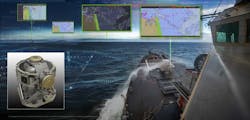Navy asks Northrop Grumman to build shipboard inertial navigation for surface warship and submarine upgrades
CHARLOTTESVILLE, Va. – U.S. Navy shipboard navigation and guidance experts needed an inertial sensor to keep U.S. Navy surface warships on-course, even when signals from satellite navigation systems like the Global Positioning System (GPS) are lost or jammed. They found their solution from Northrop Grumman Corp.
The Navy awarded the Northrop Grumman Corp. operating unit in Charlottesville, Va., a production contract for the new AN/WSN-12 inertial sensor module (ISM) -- a next-generation sensor that improves maritime navigation in GPS-denied environments for surface ships and submarines.
The Northrop Grumman-built AN/WSN-12 ISM provides maritime positioning data with or without GPS, and is a key component of the U.S. Navy’s AN/WSN-12 Inertial Navigator System (INS), upgrading the Northrop Grumman built AN/WSN-7 INS. The 25-year-old WSN-7 is on nearly every ship in the U.S. Navy and has been the program of record for more than two decades.
“The new AN/WSN-12 Inertial Navigator System will deliver more precision and performance for the warfighter while occupying the same footprint as its predecessor.” says Todd Leavitt, vice president of naval and oceanic systems at Northrop Grumman. “This allows upgrades to be made on existing systems where space is at a premium.”
Surface ships and submarines rely heavily on the positioning data provided by GPS for navigation, for safety at sea, and to fire weapons. The AN/WSN-12 ISM helps establish assured position, navigation, and timing (A-PNT) maritime solutions in the absence of satellite navigation technology.
The first ISM will be fielded later this year, Northrop Grumman officials say. Northrop Grumman reported completion of the ISM's preliminary design review in May 2016, and critical design review in June 2018.
The ISM will help will provide mission critical ship positioning, velocity, and altitude data to shipboard sensors, combat systems, guns, and missile systems. It will use an open-systems architecture using a modular design, standards-based interfaces, and widely supported consensus-based standards.
For more information contact Northrop Grumman online at www.northropgrumman.com.
